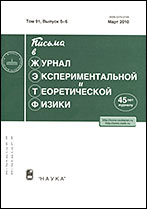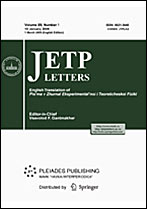|
|
Pis'ma v Zhurnal Èksperimental'noi i Teoreticheskoi Fiziki, 2012, Volume 95, Issue 1, Pages 23–28
(Mi jetpl2412)
|
 |
|
 |
This article is cited in 3 scientific papers (total in 3 papers)
CONDENSED MATTER
Features of the structure and properties of $\beta$-FeSi$_2$ nanofilms and a $\beta$-FeSi$_2$/Si interface
A. S. Fedorova, A. A. Kuzubovb, T. A. Kozhevnikovab, N. S. Elyseevab, N. G. Galkinc, S. G. Ovchinnikovab, A. A. Saraninc, A. V. Latyshevd
a L. V. Kirensky Institute of Physics, Siberian Branch of the Russian Academy of Sciences
b Siberian Federal University, Krasnoyarsk
c Institute for Automation and Control Processes, Far Eastern Branch of the Russian Academy of Sciences, Vladivostok
d A. V. Rzhanov Institute of Semiconductor Physics of SB RAS, Novosibirsk
Abstract:
The electronic, geometric, and magnetic structure of nanofilms of the в phase of iron disilicide FeSi$_2$ with the (001), (100), and (010) surfaces have been simulated through density functional calculations. A substantial reconstruction of the (001) surface terminated with silicon atoms has been observed, which was accompanied by an increase in the surface symmetry and appearance of “squares” of silicon atoms. Analysis of the electron density of states (DOS) and spin DOS projected on the contributions of layers of atoms (LSDOS) indicates that all plates have metallic properties. The main contribution near the Fermi level comes from the surface iron layers and it decreases rapidly with an increase in the distance from the surface of the plate. Analysis of the calculated effective magnetic moments of atoms shows that the surface layers in the plates have a significant magnetic moment, in particular, iron layers on the (001) surface ($1.89 \mu_{\rm B}$/atom). The moments of atoms decrease rapidly with an increase in their distance from the surface. The electron and geometric regions of a (001)Si/FeSi$_2$ interface have been studied. Analysis of the LSDOS shows that the surface conducting state mainly determined by the contribution from the near-surface silicide layers is implemented in this region. The possibility of the formation of the perfect and sharp Si/FeSi$_2$ interface has been demonstrated.
Received: 21.10.2011
Revised: 29.11.2011
Citation:
A. S. Fedorov, A. A. Kuzubov, T. A. Kozhevnikova, N. S. Elyseeva, N. G. Galkin, S. G. Ovchinnikov, A. A. Saranin, A. V. Latyshev, “Features of the structure and properties of $\beta$-FeSi$_2$ nanofilms and a $\beta$-FeSi$_2$/Si interface”, Pis'ma v Zh. Èksper. Teoret. Fiz., 95:1 (2012), 23–28; JETP Letters, 95:1 (2012), 20–24
Linking options:
https://www.mathnet.ru/eng/jetpl2412 https://www.mathnet.ru/eng/jetpl/v95/i1/p23
|


| Statistics & downloads: |
| Abstract page: | 351 | | Full-text PDF : | 98 | | References: | 57 | | First page: | 10 |
|





 Contact us:
Contact us: Terms of Use
Terms of Use
 Registration to the website
Registration to the website Logotypes
Logotypes








 Citation in format
Citation in format 
